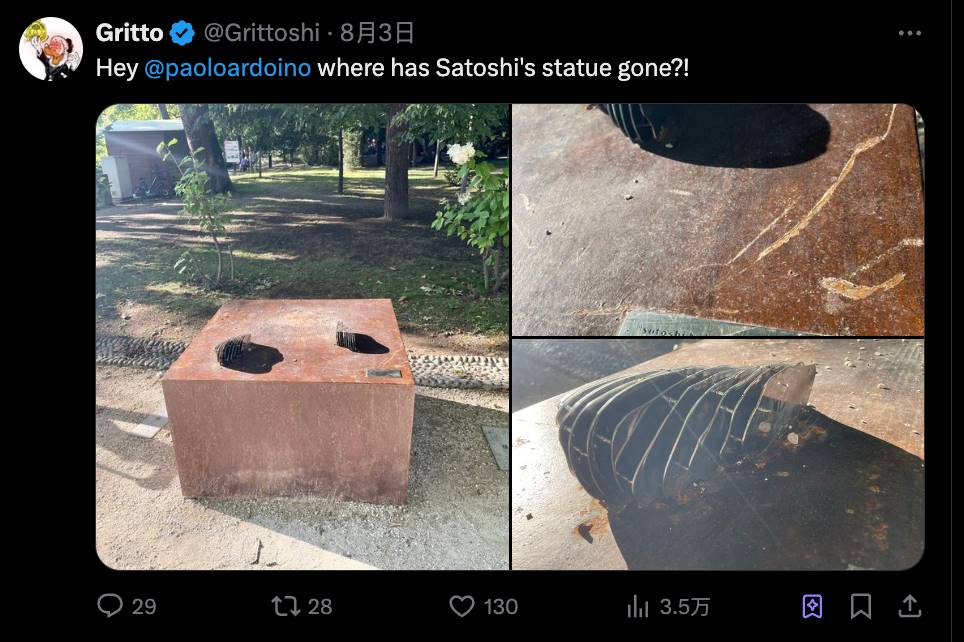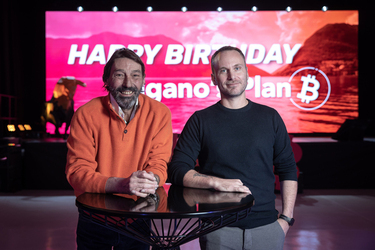The night the Satoshi Nakamoto statue spent at the bottom of the lake may be the most ironic moment since its existence.
Written by: David, Deep Tide TechFlow

On the morning of August 3, in Lugano, Switzerland, municipal workers retrieved several pieces of stainless steel from the lake.
Just hours earlier, these pieces were part of a complete statue of Satoshi Nakamoto. A tribute from a city to the creator of Bitcoin has now become scrap metal at the bottom of the lake.
Twitter user @Grittoshi was the first to notice the statue was missing. He recalled that on the evening of August 1, Switzerland's National Day, the statue still stood in Parco Ciani park. Nearby, young people were raising their glasses in celebration at an outdoor café.
A few hours later, this artwork, which took 21 months to design and was said to "disappear" when viewed from the front, truly vanished—in a way no one expected.

Satoshigallery, an art group dedicated to erecting Satoshi Nakamoto statues in 21 cities worldwide, quickly offered a reward of 0.1 Bitcoin on social media for clues.
However, the process of solving the mystery turned out to be surprisingly simple.
It was still netizen @Grittoshi who applied "Occam's Razor" to deduce: drunken revelers passing by the statue on National Day might have whimsically decided to "have some fun." They couldn't have moved the statue too far; it was most likely thrown into the nearby lake.
A few hours later, his guess was confirmed—the municipal workers indeed fished out the shattered Satoshi Nakamoto from the lake.
No one was arrested, and perhaps no one ever will be. To the locals, this was likely just a prank by a group of drunken youths.
The statue was only secured to its base by two welding points, which a few people could easily break. In a sense, this is more frustrating than premeditated vandalism: to the destroyers, this valuable statue was merely a toy for drunken amusement.
The statue was indeed broken. Satoshigallery posted on Twitter: "You can steal our symbol, but you can never steal our soul."
Satoshi Nakamoto is indeed the soul of the entire crypto industry, but not necessarily of Lugano, Switzerland.
Behind the grand declaration, last October, the statue was unveiled at Lugano's most important blockchain conference, with the mayor personally endorsing it as a representation of the city's spirit of digital innovation.
In less than a year, it was thrown into the lake by the citizens.
As the Lugano city government ambitiously vowed to become the "Crypto Capital of Europe," there may exist a deeper chasm than Lake Lugano between the official warm embrace and the genuine attitude of the locals in Switzerland, the world's most crypto-friendly country.
The statue can be salvaged, but what about trust?
Lugano's Plan B: A Crypto Capital Built on Money?
In March 2022, when Bitcoin was still hovering around $40,000, Lugano's mayor Michele Foletti stood in the spotlight to announce an ambitious plan. Beside him was Paolo Ardoino, the CTO of stablecoin giant Tether.
The two jointly announced the "Plan B" initiative, aiming to make this small southern Swiss city with a population of just 60,000 the "Crypto Capital of Europe."

Plan B, as the name suggests, is an alternative solution. When the traditional financial system fails, cryptocurrency is that Plan B. But for Lugano, this name carries another meaning—when other Swiss cities are already far ahead in the crypto race, it needs a Plan B to overtake.
Two years later, the report card looks quite impressive:
According to data released by Tether, the Plan B forum in October 2024 set a record, attracting over 2,500 global participants. During the week of the forum, Lugano recorded 6,121 cryptocurrency transactions.
Nearly 100 merchants in the city accept Bitcoin and USDT payments, and 300 accept the city token LVGA. Even the jerseys of the Lugano football club feature the Bitcoin logo.
But looking closely at these numbers, the picture changes dramatically.
What is the total amount of those 6,121 transactions? $160,000. So the average transaction is $26. This data is still too low.
"We chose to print the Bitcoin logo on the jerseys instead of Tether for educational purposes," Ardoino said in an interview. But local merchants privately complain that most customers still prefer to pay by card or cash. Accepting crypto payments feels more like complying with the city's requirements rather than a commercial necessity.
More subtly, there is the relationship between Lugano and Tether. This largest stablecoin issuer in the world is not only the main sponsor of Plan B but also deeply involved in the city's digital transformation.
The question is, is it really wise to bet the city's crypto future on a commercial company, especially one that is itself controversial—Tether's reserve transparency issues still loom over the crypto world like the sword of Damocles.
The incident of the Satoshi Nakamoto statue being thrown into the lake seems to have become a kind of prophecy.
This supposedly expensive artwork, designed to pursue visual effects—appearing to "disappear" from certain angles—neglected the most basic safety considerations, being secured by only two welding points.
Is this superficial focus on form over substance also a microcosm of the entire Plan B?
While the crypto ecosystem naturally grew through years of accumulation within the community, Lugano chose a shortcut: paving the way with money and creating hype through marketing. But just like that statue sinking to the bottom of the lake, a technological transplant without social soil may ultimately be nothing more than an expensive decoration.
Switzerland's Crypto Landscape: Lugano's Misaligned Competition
If we compare Switzerland's crypto landscape to a marathon, Lugano is undoubtedly the runner who started the latest but is running the hardest.
Zug, a small city with a population of only 30,000, began its crypto journey as early as 2013. When entrepreneur Johann Gevers moved his company Monetas here, "Crypto Valley" was still just a beautiful vision borrowed from Silicon Valley. But by 2024, Zug had gathered 719 blockchain companies, accounting for 41% of the total in Switzerland.

More importantly, this is where Ethereum was born—if Bitcoin is the Adam of the crypto world, Ethereum is Eve.
The numbers are cold, but they tell vastly different development paths. In Zug, 47% of financial services blockchain companies and 43% of infrastructure companies chose to settle here. This is not the result of government planning but a natural market selection. Low tax rates, relaxed regulations, and most importantly—a organically grown entrepreneurial ecosystem.
People working in blockchain companies in Zug likely live in the same community, their children attend the same school, and they discuss technical issues at the same bar on weekends.
In contrast, the entire Ticino region, where Lugano is located, has only 103 blockchain companies, but Lugano is unwilling to play a supporting role.
When they launched Plan B in 2022, their strategy was clear: since they couldn't replicate Zug's first-mover advantage, they would take a different path. Zug is a paradise for engineers, Geneva is the home of compliance experts, Zurich is the center of fintech, so what does Lugano want to become?
The answer is a testing ground for consumer applications.
Lugano chose a seemingly sexier path: allowing ordinary people to use cryptocurrency. But in the two years since Plan B was launched, those merchants accepting Bitcoin payments are more likely to be participating in a performance rather than driven by real demand.

Local McDonald's in Lugano accepts Bitcoin payments
Source: PlanB.lugano
Even more awkward is the internal competition among Swiss cities. In 2023, Zug announced it would raise the cryptocurrency payment limit for taxes from 100,000 Swiss francs to 1.5 million Swiss francs—this is a real application scenario; the same year, Lugano also issued blockchain bonds worth 100 million Swiss francs. However, while this seems innovative, what difference does it make to ordinary citizens compared to traditional bonds?
Lugano seems to want to cover a decade's worth of ground in Zug in just two years.
But the crypto ecosystem is not about erecting statues; it requires time to ferment, needs failed projects to serve as fertilizer, and demands genuine participation from the local community.
The Satoshi Nakamoto statue being thrown into the lake may not be because the people of Lugano hate Bitcoin, but because they simply do not care.
Pushing a crypto agenda in a city lacking a crypto gene is like trying to grow rice in a desert—it's not impossible, but the cost is too high and goes against natural laws.
Metaphor of the Statue
The night the Satoshi Nakamoto statue spent at the bottom of the lake may be the most ironic moment since its existence. This artwork, designed to "pay tribute to the spirit of decentralization," ultimately required centralized municipal power to salvage it.
While the Lugano officials talk about the blockchain revolution, the citizens have their own life priorities.
Those drunken youths who threw the statue into the lake on Switzerland's National Day are likely not opponents of cryptocurrency. They destroyed the statue more likely because it happened to be there—something that looked like it could provide some fun.
This randomness is more frightening than hatred for cryptocurrency. Hatred at least means caring, while indifference means "whatever."
The deeper issue lies in the development model of "embracing crypto" itself. The success of Zug stems from a decade of natural growth, an ecosystem cultivated by entrepreneurs, investors, and tech geeks; while Lugano attempts to replicate this process in two years through top-down administrative push.
It's a bit like trying to achieve the flavor of slow-cooked food using a microwave—it looks cooked, but the taste is off.
When the government changes, when budgets tighten, when the next policy hotspot emerges, will the crypto-friendly Plan B still be a priority?
The statue can be re-welded, even reinforced to be as solid as a rock, but once the crack of trust appears, repairing it is far more difficult than imagined.
The young people who threw Satoshi into the lake are not bad people, but pushing a crypto agenda in a city that is indifferent to cryptocurrency may not yield optimistic results.
免责声明:本文章仅代表作者个人观点,不代表本平台的立场和观点。本文章仅供信息分享,不构成对任何人的任何投资建议。用户与作者之间的任何争议,与本平台无关。如网页中刊载的文章或图片涉及侵权,请提供相关的权利证明和身份证明发送邮件到support@aicoin.com,本平台相关工作人员将会进行核查。




